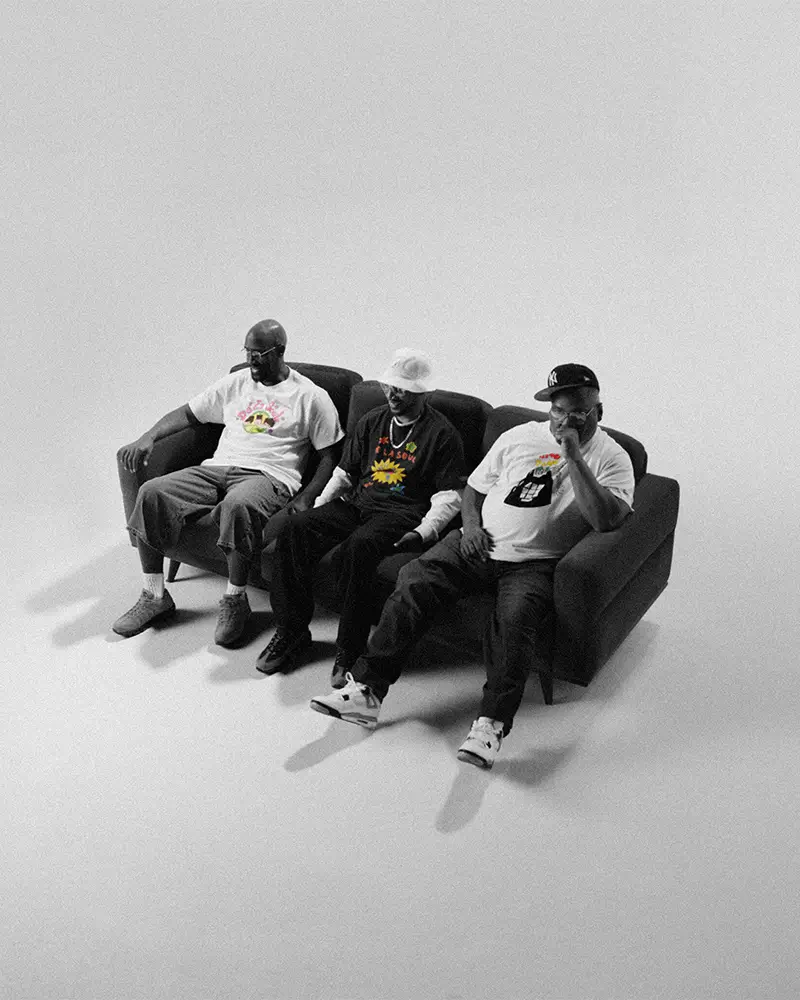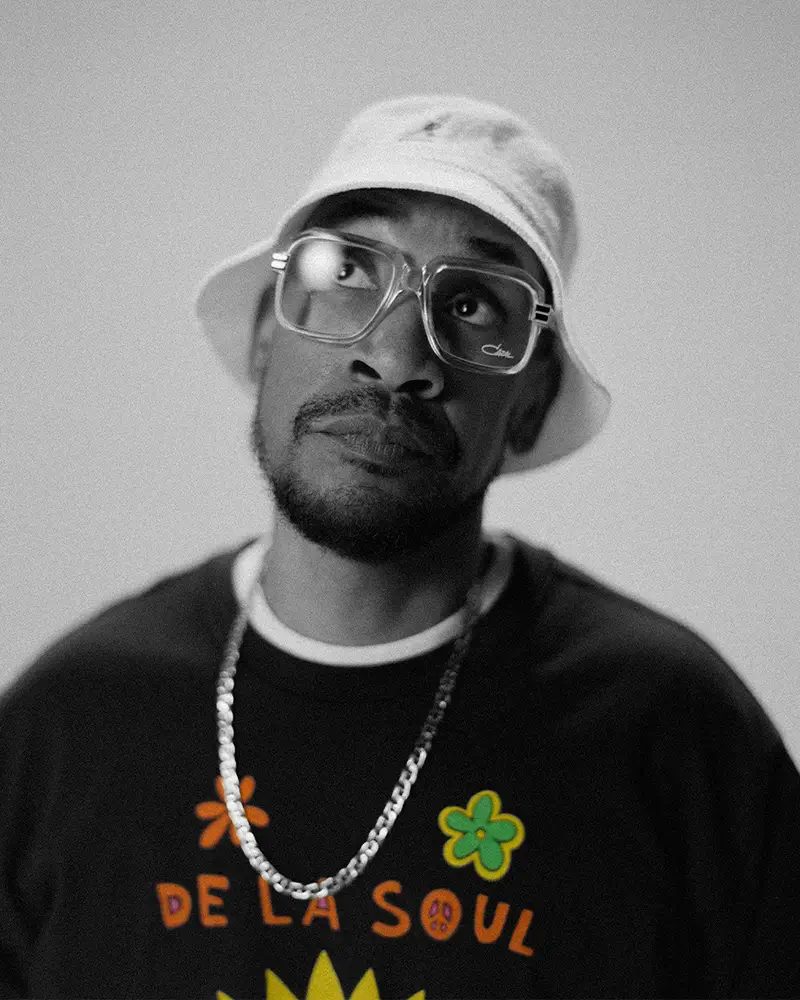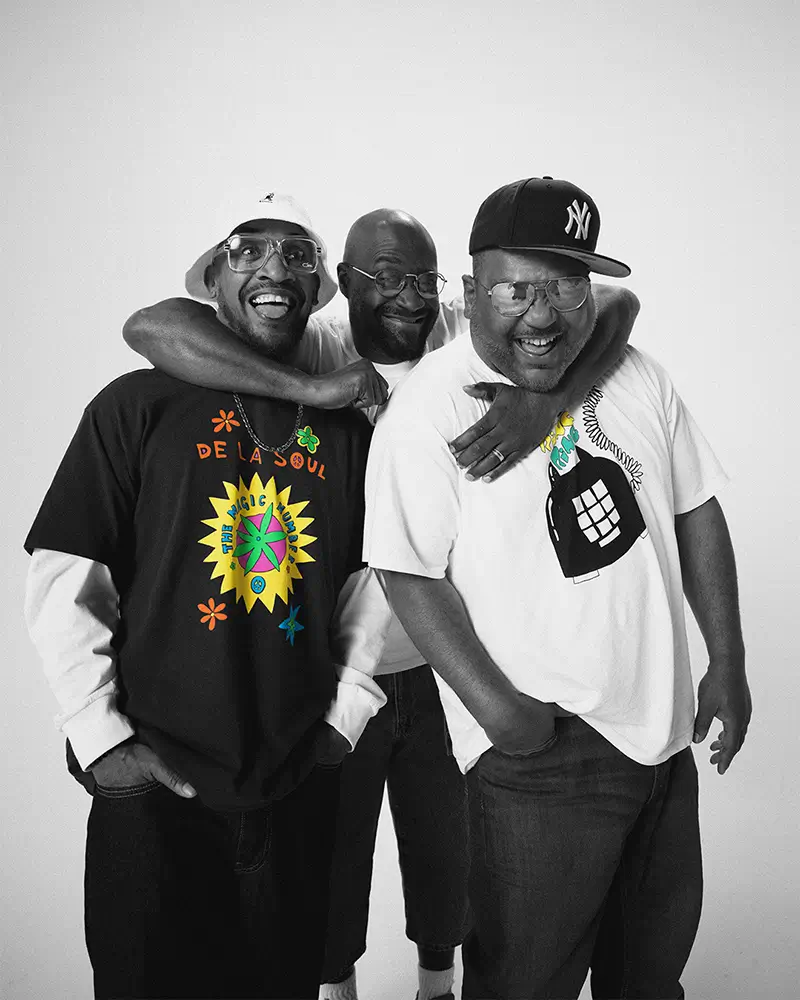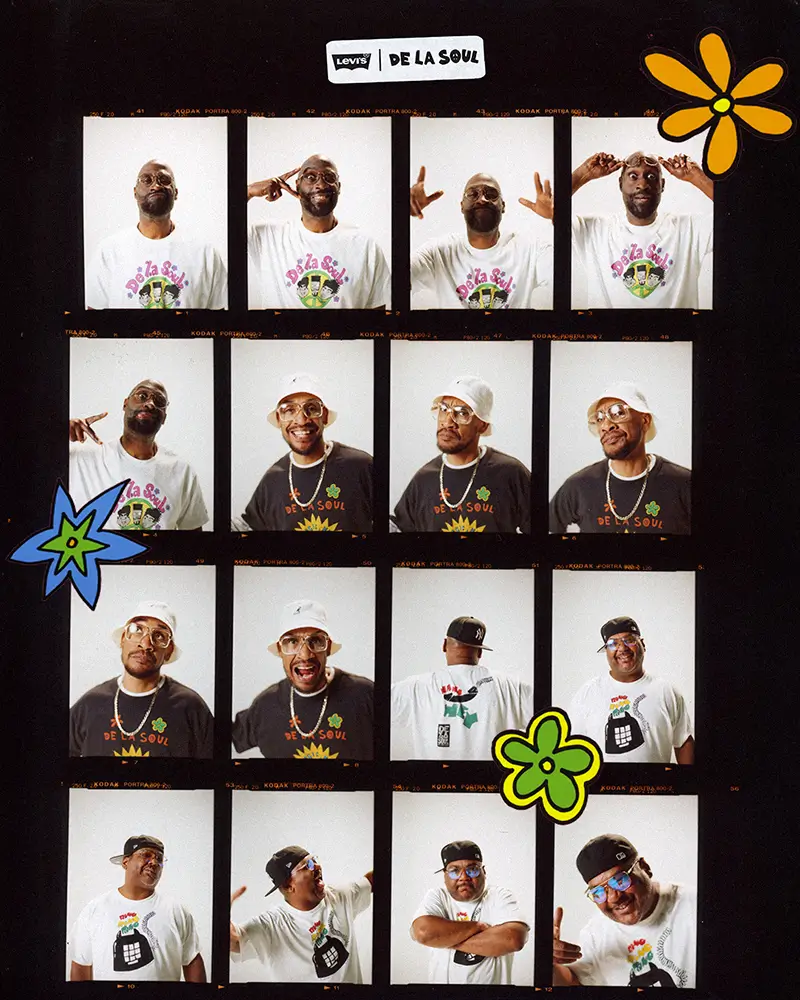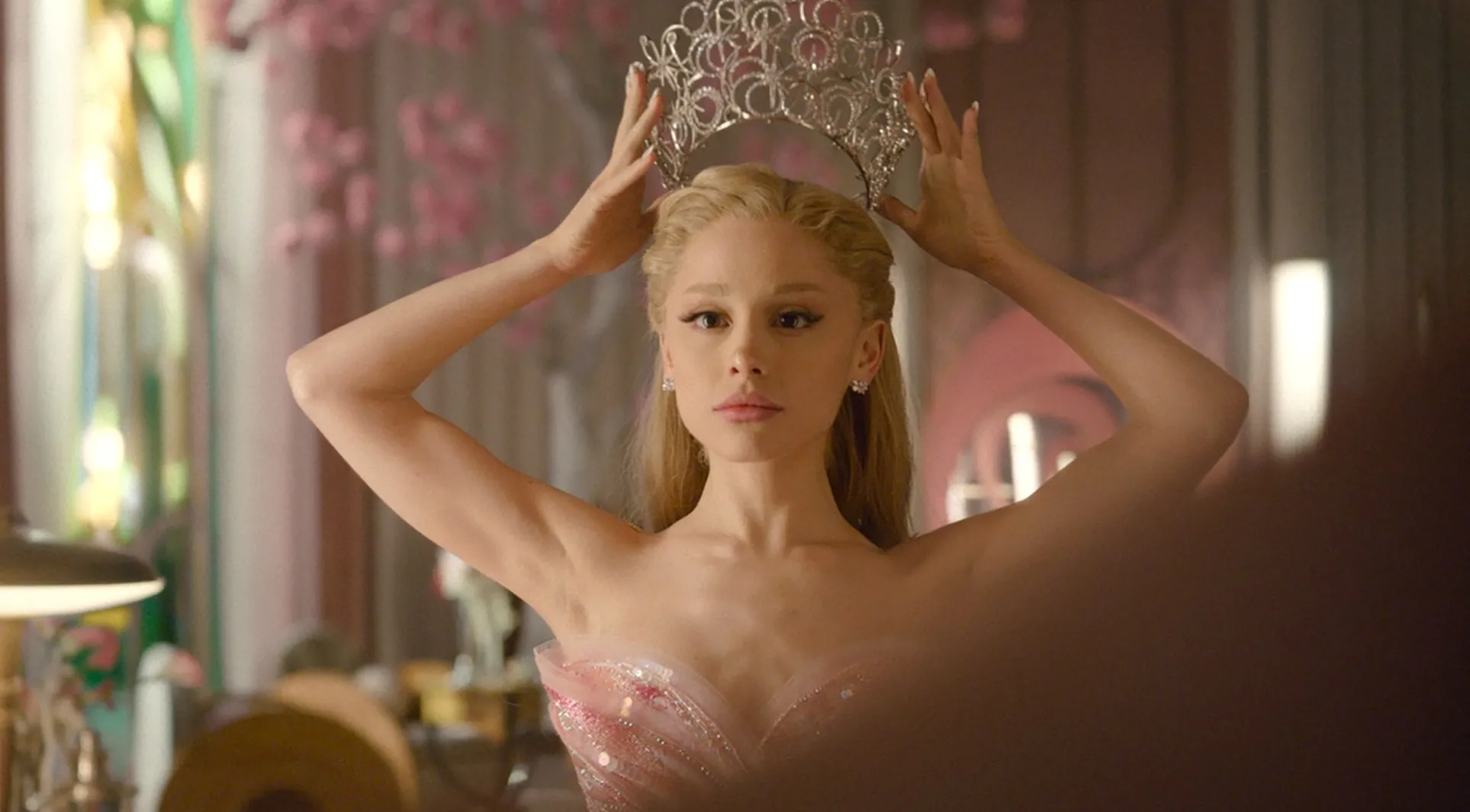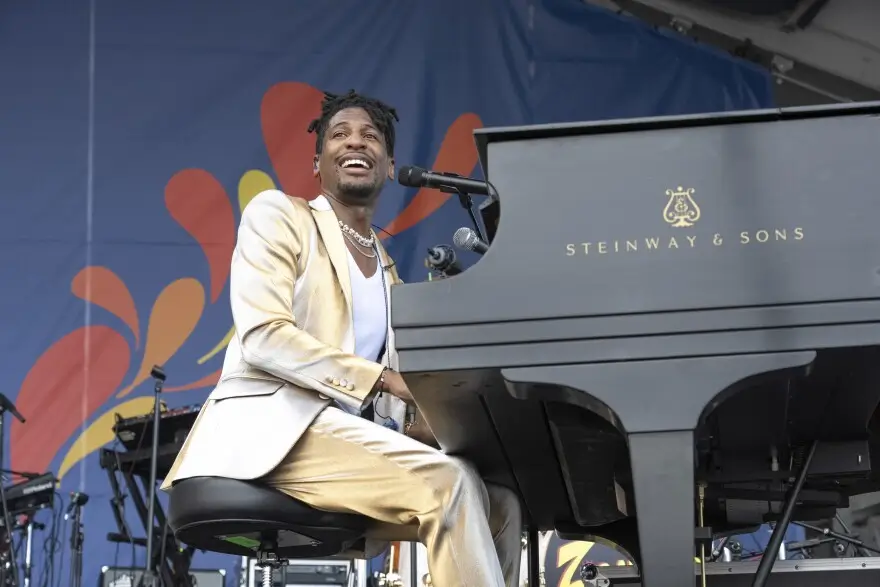intro
Every few years, the fashion world and the music world collide in a way that feels not only timely but necessary—a moment where apparel becomes a vehicle for preserving culture, amplifying legacy, and reintroducing history to a new generation. Levi’s®, the centuries-old denim titan whose roots intertwine deeply with American counterculture, has embarked on one such moment with its latest release: a limited-edition T-shirt collection inspired by vintage De La Soul samples.
More than a merch drop and more than a nostalgic remix, the project functions as a cultural restoration, a revival that bridges decades of hip-hop evolution, graphic language, and the aesthetics of a group whose influence on fashion, art direction, and visual identity is still reverberating today. De La Soul, long considered hip-hop’s avant-garde, always occupied a world slightly left of center—bold, playful, intellectual, and deliberately outside the conventions of their era. Levi’s® entering this universe is both a tribute and an archival excavation, bringing the group’s early iconography to life for a generation raised on streaming, TikTok edits, and archival streetwear.
The result is a capsule that merges Levi’s®’ heritage of Americana craft with De La Soul’s unmistakable graphic DNA. It is not a collaboration driven by hype mechanics or artificially engineered scarcity—it is driven by cultural responsibility, reverence for originality, and a desire to honor the aesthetics of one of hip-hop’s most pivotal acts.
stir
The origins of this project can be traced back to Levi’s® internal Vintage Clothing (LVC) archive, an expansive trove of denim, tees, jackets, store signage, workwear ephemera, and ad materials dating back to the 19th century. Within that archive is a more unexpected subset: samples from past cultural partnerships, music-related experiments, and test silhouettes developed for artists’ tours, concerts, or album promotions.
In early 2025, a Levi’s® archivist reportedly rediscovered a small envelope of early-1990s T-shirt concept samples—unreleased graphics, typography drafts, and card stock mockups referencing the visual world of De La Soul’s “3 Feet High and Rising” era. These were not official releases; they were preliminary design studies from an early brainstorming effort between Levi’s® and the group that ultimately never made it to market.
The rediscovery sparked an internal conversation: what if these forgotten designs could be reinterpreted for a contemporary audience? What if Levi’s® could bring these vintage samples to life, not by recreating them verbatim, but by contextualizing them within the modern ecosystem of graphic T-shirt culture?
When Levi’s® reached out to the group—now complete with the long-awaited streaming release of their catalog and a resurgence of global attention—the idea resonated immediately. De La Soul’s surviving members, Posdnuos and Maseo, saw the project as a chance to honor their late bandmate Trugoy the Dove and celebrate the visual language that defined the group’s golden era.
de la soul
To understand why this collaboration matters, one must understand De La Soul’s place within the evolving lineage of hip-hop aesthetics. Emerging from Long Island in the late 1980s, they disrupted everything—sound, style, rhythm, narrative, even the visual frameworks of rap’s early identity.
Their debut album, “3 Feet High and Rising,” arrived in 1989 not as a rap album, but as an audiovisual experience. The cover—designed by artist collective the Grey Organization—featured bright daisies, eccentric doodles, surreal iconography, and a palette more reminiscent of psychedelic pop art than anything typical of the hip-hop scene. In an era dominated by stark B-boy imagery, gold chains, and bombastic typography, De La Soul embraced whimsy, fluidity, and experimentation.
Their music videos—“Me Myself and I,” “Buddy,” “Say No Go”—became aesthetic touchstones, blending animation, collage, everyday clothing, thrift-shop styling, and surreal motifs. They were the group who made eclecticism fashionable before eclecticism was a mainstream aesthetic.
This visual irreverence became their signature. It is precisely this world that Levi’s® reenters: not the literal past, but the imaginative universe De La Soul created.
vintage
The T-shirt samples found in Levi’s® archive were never meant to be seen publicly. They were design tests—some monochromatic, some vibrant, some graphically dense, others charmingly minimal. Each one captured a different facet of De La Soul’s early aesthetic vocabulary.
Some referenced the daisy motif—hand-drawn petals, distorted outlines, childish scribbles that echoed the visual innocence the group used to subvert hip-hop norms. Others incorporated textural elements inspired by cassette culture: blocky lettering, photocopy-style grain, imperfect edges, and lo-fi gradients reminiscent of hand-assembled zines.
There were also typography explorations using warped letterforms, scratchy strokes, and bubble-letter variations similar to what one would see on early ’90s school folders or skate magazines. De La Soul’s graphics always had a tactile quality—playful and purposeful in equal measure.
These archived concepts became the foundation for the 2025 capsule. Levi’s® design team approached them not as retro artifacts, but as creative prompts.
capsule
Levi’s® wanted the final T-shirts to feel authentically vintage—not in an artificially distressed sense, but in craftsmanship and spirit. The silhouettes mimic the slightly boxy, pre-streetwear proportions of late ’80s tees. The cotton used is heavier than contemporary basics, giving each piece the drape, weight, and durability of true archival apparel.
Graphics were screen-printed using techniques that intentionally preserved some of the imperfections found in the samples. Ink saturation varies slightly from shirt to shirt, a nod to the analog processes that defined the era. Some designs even feature misaligned layering—a classic trait of old-school screen-printing that modern brands often avoid but which Levi’s® intentionally celebrated.
The palette embraces De La Soul’s iconic boldness: sunshine yellow, electric blue, chalk white, washed black, neon green. These choices echo not only the “3 Feet High and Rising” era but also the group’s broader ethos: brightness as a cultural weapon, joy as protest, color as refusal.
The capsule includes multiple graphic narratives:
- tees featuring the daisy motif reworked in new compositiontees featuring archival typography drafts layered into collage-like structures
- tees incorporating original phrases, obscure references, and Easter eggs fans will instantly recognize
- tees inspired by De La Soul’s sampling culture, visually remixing their famous cut-and-paste musical style into graphic assemblage
Each piece is both a wearable artifact and a contemporary streetwear object—timeless yet distinctly of the moment.
flow
At first glance, Levi’s®—a heritage denim brand synonymous with Americana—might seem an unexpected partner for De La Soul, the avant-garde hip-hop trio from Long Island. Yet the connection is surprisingly intuitive.
Levi’s® has long aligned itself with cultural movements anchored in individuality, rebellion, and subculture. From its role in mod fashion to ’70s counterculture to ’90s skate culture to today’s archival revival, Levi’s® thrives at the intersection of personal expression and everyday wearability.
De La Soul, meanwhile, has always championed authenticity over assimilation, imagination over conformity. They are a group whose identity evolved outside the archetypes of rap’s early mainstream. The Grey Organization once described their visual direction as a “psychedelic explosion against monochrome industry norms”—a line that perfectly encapsulates why Levi’s® wanted to revisit this moment.
In that context, the collaboration becomes not only logical but inevitable. Both brands share a philosophy of reinvention, a reverence for craft, and a commitment to the idea that art can emerge from the most accessible materials: denim, cotton, samples, collage, community.
idea
The choice to base the capsule on vintage samples rather than new illustrations speaks to a broader cultural shift. The fashion and music industries are collectively reassessing the archival past—mining it not to replicate nostalgia but to understand how cultural artifacts evolve when revisited.
Samples, in particular, hold a unique place in hip-hop culture. They symbolize memory, borrowing, homage, revision, and innovation. Much like musical sampling, graphic sampling recreates a dialogue between eras, remixing the familiar into something new.
What Levi’s® has done here is effectively apply the logic of sampling to apparel. The brand reinterprets visual fragments, typography experiments, and early unreleased ideas—transforming them into fully realized garments. It mirrors what De La Soul did musically on “3 Feet High and Rising,” where layers of samples became a new form of expression.
In this way, the capsule becomes an artistic echo: sampling the samples.
why
The timing of this launch is no coincidence. 2023 marked the long-delayed release of De La Soul’s catalog on streaming platforms, a milestone in digital history after years of legal limbo. The group saw a massive cultural resurgence, with younger listeners discovering them for the first time and older fans reuniting with music they had not been able to access in decades.
Meanwhile, Y2K nostalgia, graphic tees, and archival streetwear continue to dominate global fashion cycles. Vintage Levi’s® has become practically its own economy, and classic hip-hop imagery fuels the aesthetic language of everything from TikTok edits to collectible posters.
There is also a renewed focus on preserving hip-hop history as the genre continues past its fiftieth anniversary. Documentaries, reissues, exhibitions, and academic research have broadened the lens through which groups like De La Soul are evaluated. They are no longer simply “alternative rap pioneers”—they are foundational architects of modern creativity.
Launching this capsule now allows Levi’s® to participate in that cultural moment, reinforcing De La Soul’s legacy while offering fans an object of both fashion value and historical significance.
mem
The beauty of this collection lies in its ability to function as both apparel and memory. To the longtime fan, these shirts evoke a specific era—one defined by cassette players, hand-drawn flyers, late-night radio shows, and the golden age of sampling. To a younger audience discovering De La Soul through digital platforms, the shirts serve as an entry point—a tactile connection to a musical past that exists largely in streaming algorithms.
They also speak to the contemporary desire for objects with emotional resonance. In an age where fashion cycles move at record speed, there is growing appreciation for pieces rooted in narrative, craftsmanship, and history.
Levi’s® understands that nostalgia is not about replicating the past—it is about preserving emotional truth. The vintage samples chosen for the capsule carry the imperfections, playfulness, and experimentation that defined De La Soul’s identity. Wearing them becomes a gesture of remembrance and renewal.
culture
What happens next is almost predictable: these shirts will enter the cultural bloodstream, appearing at concerts, festivals, vintage markets, Instagram fit grids, TikTok style edits, and archive-inspired streetwear communities. Limited-edition Levi’s® pieces—especially music-related ones—tend to gain long-term resale interest, not because of hype but because of cultural meaning.
Beyond fashion cycles, this capsule may inspire new conversations around De La Soul’s visual legacy, sparking exhibitions, retrospectives, or deeper study of the group’s art direction. As an object category, graphic tees often sit at the intersection of music merchandising and visual art. They are wearable posters, mobile archives, carriers of collective memory.
Levi’s® has effectively cemented De La Soul’s visual universe in a new material format—one that can be worn, preserved, collected, and passed down.
fin
The Levi’s® x De La Soul T-shirt collection is more than a nostalgia project. It is a cultural bridge: connecting eras, reviving dormant imagery, and honoring the experimental brilliance of a group that changed hip-hop’s visual grammar. By drawing on vintage samples—unreleased concepts that once lived quietly in a corporate archive—Levi’s® has not only revived a creative moment but also expanded it, giving form to ideas that never had the chance to reach the public.
In doing so, the brand reinforces its own legacy as a custodian of cultural storytelling. De La Soul and Levi’s® may come from different worlds, but they share a commitment to authenticity, community, and expressive freedom. This capsule is their intersection—an archival rebirth that transforms 30-year-old sketches into contemporary fashion objects.
It is, in the truest sense, a celebration of creativity in all its forms: sampled, remixed, remembered, and reimagined.
No comments yet.

